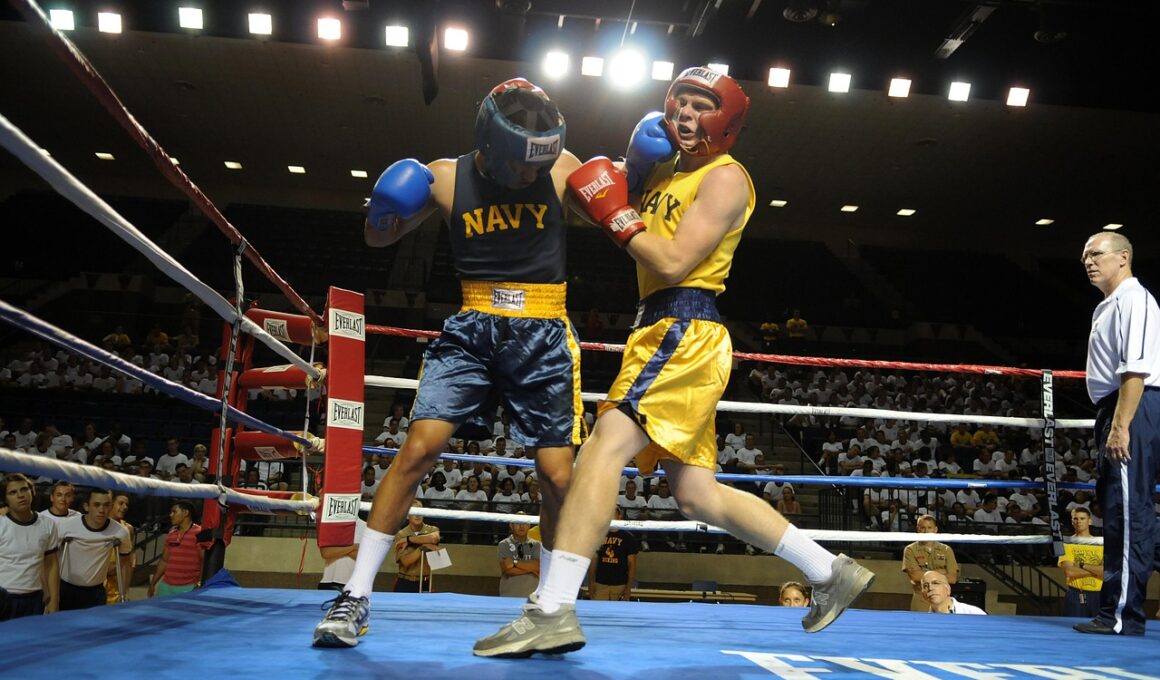How to Analyze Boxing Tournament Fight Footage Effectively
Analyzing boxing tournament fight footage is an essential skill for coaches, trainers, and fighters alike. The insights gained from watching matches can significantly impact a boxer’s performance and training strategies. Start by reviewing specific aspects of the fight, such as footwork, guard position, and punch selection. These categories help you dissect a bout effectively. Pay attention to the fighters’ striking techniques and defensive maneuvers, as this reveals their fundamental skills and areas of expertise. Having a checklist while assessing fights ensures that you cover all critical points without missing any details. Consider the context of the match as overall strategies might change depending on the opponent. For example, did the fighter adapt when facing a particular style? This adaptability is crucial for success in future competitions. To facilitate your analysis, it is beneficial to take notes directly on the footage. Use timestamps for significant moments, which will help you assess patterns and trends over time. This documentation will provide insights during training sessions and crucial moments in fights. It’s essential to remain objective and analytical throughout the review process.
Identifying strengths and weaknesses is a vital aspect of your analysis. Once you have gathered your notes, categorize them based on recurring themes or traits seen during the fights. This approach allows you to bring clarity to the evaluation process. Think about which techniques worked well for the fighter and which didn’t, and note if improvements can be made. Engage in discussions with fellow trainers or fighters, where you can share insights and generate constructive dialogue. This collaborative learning process deepens your understanding and incorporates varying perspectives. Encourage boxers to watch their footage as well, allowing them to develop their judgment and understanding of their performance. Imitating certain techniques observed from successful bouts can also help fighters adopt effective strategies. Furthermore, leveraging technology can provide enhanced methods for analysis. Various software applications focus on motion tracking, delivering comprehensive breakdowns of punch velocity and footwork movements. Such tools can be incredibly beneficial for trainers seeking to improve the accuracy of their assessments. The use of slow-motion features will highlight essential insights, dissecting each move frame by frame to enhance the training experience.
Context Matters in Analysis
Understanding the context of each bout is crucial for analysis. Every match possesses unique dynamics, including fighters’ motivations, environment, and even promotional events leading up to the contest. Recognize how these factors shaped the fight outcome. For instance, did a lackluster audience affect a boxer’s mental approach? These attributes impact performance, emphasizing the need for a holistic understanding of all factors involved. Likewise, external variables such as injury, weather, and pre-fight reports impact performance. Boxers who are injured may demonstrate different techniques than their fully healthy counterparts. Hence, capturing the fight context, both in the ring and outside of it, is paramount for accurately assessing performance. Trainers and analysts alike should compile not only the fight footage but also take notes during weigh-ins, press interviews, and other promotional events. This ensures a more in-depth understanding of what influences fighters’ mindsets. Being aware of potential distractions allows for better training focus and addresses areas where improvement is needed. In turn, these insights can be translated into actionable strategies for fighters, enhancing their overall performance in future matches.
The importance of pattern recognition cannot be overstated in fight analysis. As you observe more footage, you’ll start to identify trends in both your fighter’s and opponents’ performances. For example, does an opponent consistently drop their guard after throwing a jab? Identifying these trends allows you to formulate strategies that leverage these weaknesses effectively. Optimize the training focused on exploiting these patterns; sparring sessions can incorporate scenarios highlighting these tendencies. Boxers should be encouraged to adapt their fighting style by understanding their opponent’s recurrent tactics. Emphasizing anticipation leads to improved defensive readiness and increases the chances of successfully capitalizing on openings. A subsequent benefit includes developing mental fortitude to remain composed when a specific pattern resurfaces in the ring. This cognitive approach aims to condition your boxers to expect certain movements while simultaneously preparing them to respond effectively. Further discussions with the athlete should center on how well they manage to counteract those patterns during sparring or actual matches. These discussions contribute a wealth of knowledge and experience to refine their skill set, fostering growth and development through practical exercises.
Utilizing Statistics for Better Insights
Incorporating statistics during fight analysis offers a structured approach to evaluating performance. Rather than relying solely on subjective observations, assigning numerical values to various aspects of a fighter’s performance adds a layer of objectivity. There is a multitude of analytics available, from punch statistics to round analysis. For example, counting total punches thrown, landed, and missed provides a quantifiable measure of efficiency. Similarly, consider metrics such as accuracy, defensive strikes, and engagement levels. With these bases covered, patterns emerge from the statistical data that correlate with the observed footage. Graphical representations of statistics can aid in quick comprehension of performance rates across fights. Using these graphs during discussions encapsulates complex analyses in simple, visual formats that any boxer can understand. Next, compile scores across various categories to evaluate overall progression over time. Frequent evaluations create trends, helping identify when specific aspects have improved and guide targeted training sessions moving forward. This dual approach utilizing footage alongside statistics promotes a well-rounded fight analysis methodology, giving trainers and fighters the tools required for success in the competitive boxing landscape.
After completing your analysis, the most vital step is implementing the gained insights into practical training. No analysis would yield benefits if not translated into actionable techniques and drills. Have a dedicated training focus based on both the fighter’s strengths and the identified areas for improvement, allowing focused practice sessions. For example, if footwork presented an issue during fights, design drills to enhance agility, balance, and lateral movement. Additionally, reinforcement through sparring can solidify newly learned techniques. These sessions should simulate real fight conditions, offering insights on how well pupils can implement the concepts discussed. Encourage boxers to practice adjusting their strategies based on their ongoing assessments. Utilizing role-playing scenarios can enhance their adaptability further. Moreover, keep regular reviews of the footage, combining previous insights with current performance evaluations. Continuous improvement requires making fight analysis a routine practice, ensuring each fight becomes a stepping stone for the next. As fighters grow in their understanding, their capability will increase, leading to better performance in future tournaments. This process creates a self-sustaining cycle promoting growth and excellence inside the boxing ring.
Conclusion and Reflection
Reflecting on the entire analysis process provides clarity and direction for both trainers and fighters. The entire objective is to foster a supportive environment encouraging continual development. Regular discussions on performance should be scheduled, creating a culture of sharing knowledge and questioning assumptions. When boxers become receptive to critique, it opens doors to improvement. Facing an opponent isn’t solely about physicality; it also involves a mental battle. Emphasizing mental preparations, including visualization and mental rehearsal from footage, can greatly improve fight readiness. Coupling footage analysis with mental training serves to enhance overall performance during competitions. The learning from each fight should lead to adjustments in strategies, reinforcing the idea that every bout serves as a learning opportunity. Encourage boxers to engage in self-reflection after each match to assess personal goals and aspirations moving forward. This ensures that both trainers and fighters are aligned in their objectives, fostering deeper connections. Ultimately, the essence of fight analysis is rooted in progress, dedication, and a commitment to excellence. As the boxing landscape evolves, effective analysis will remain a cornerstone of success in tournament coverage and overall boxing fitness.


